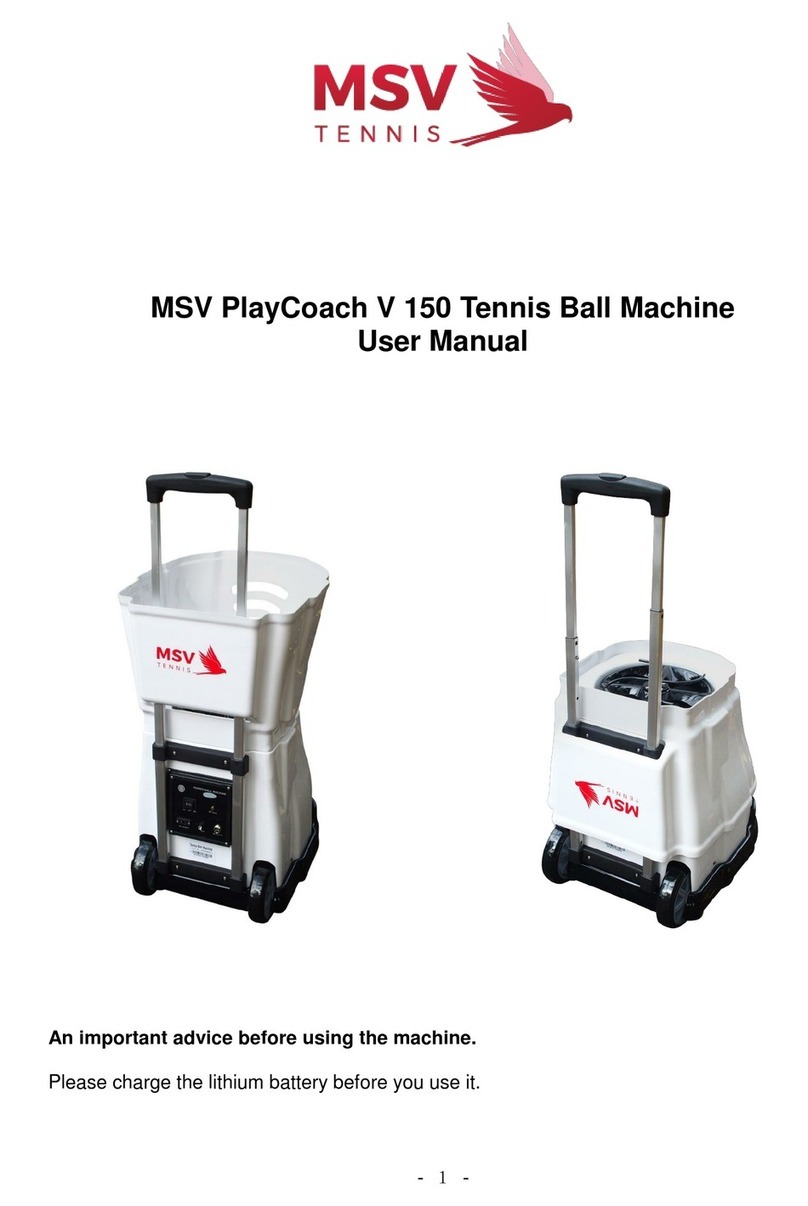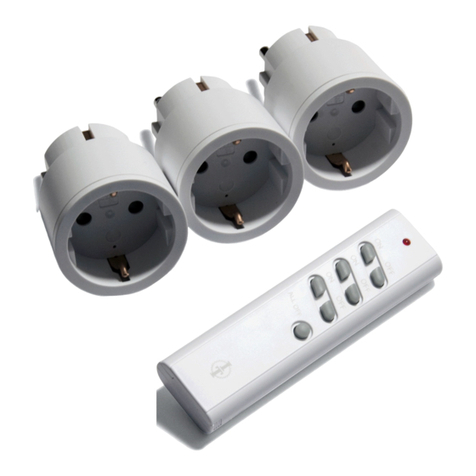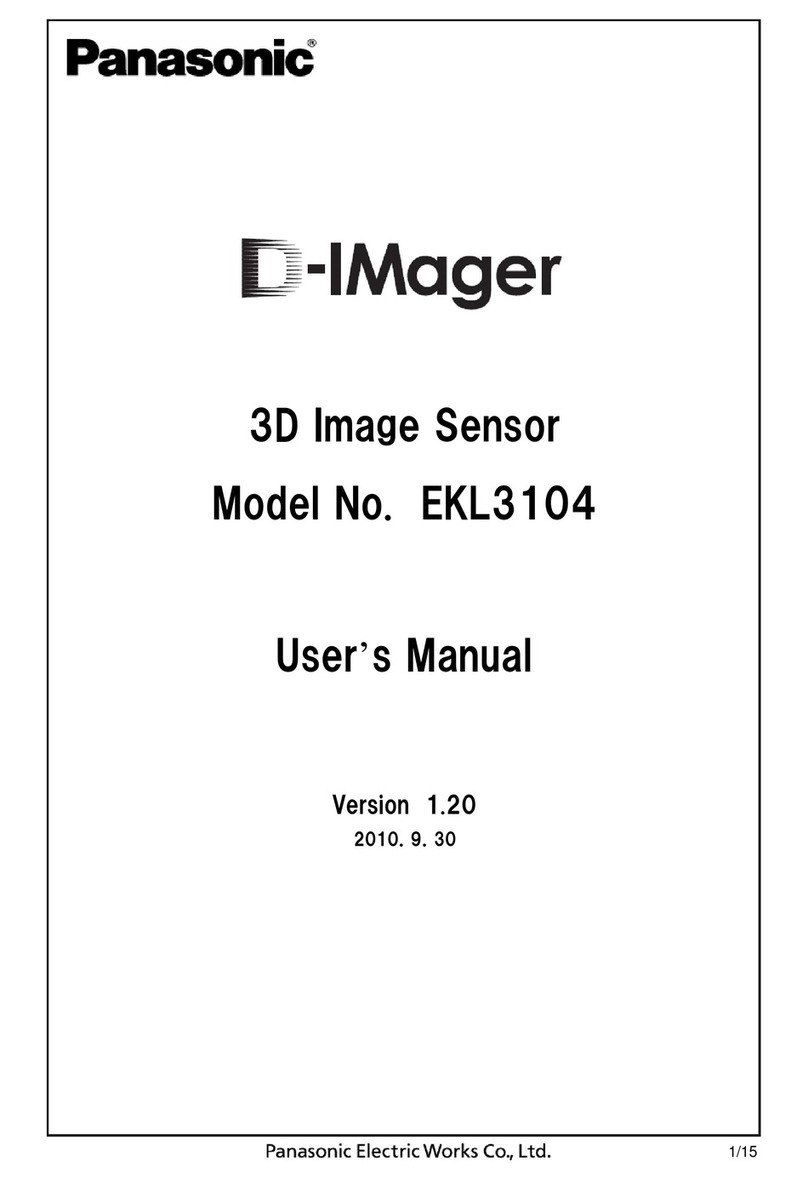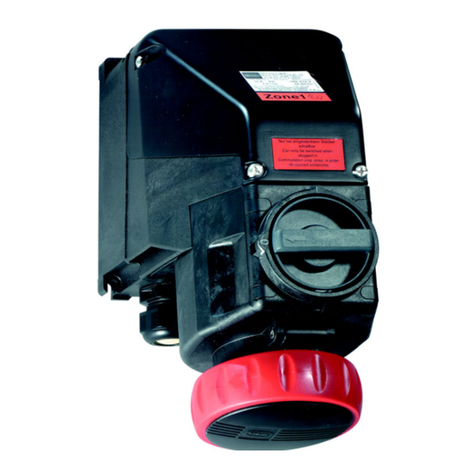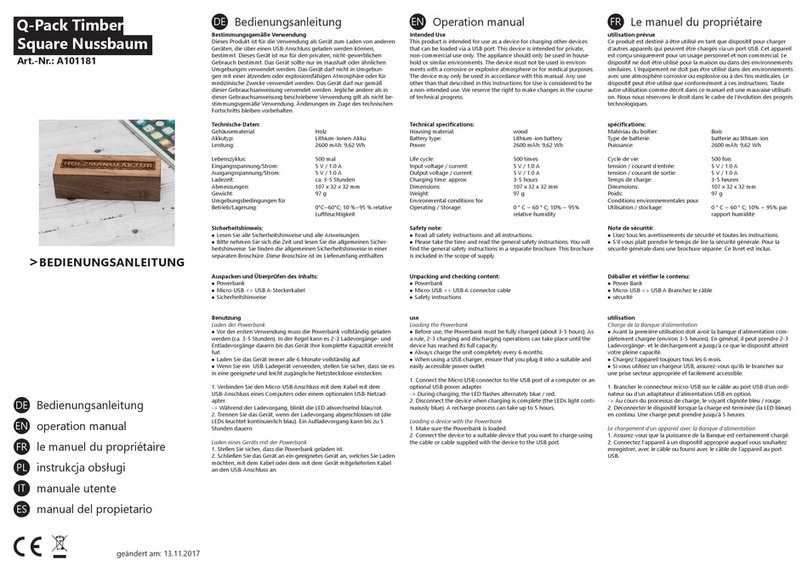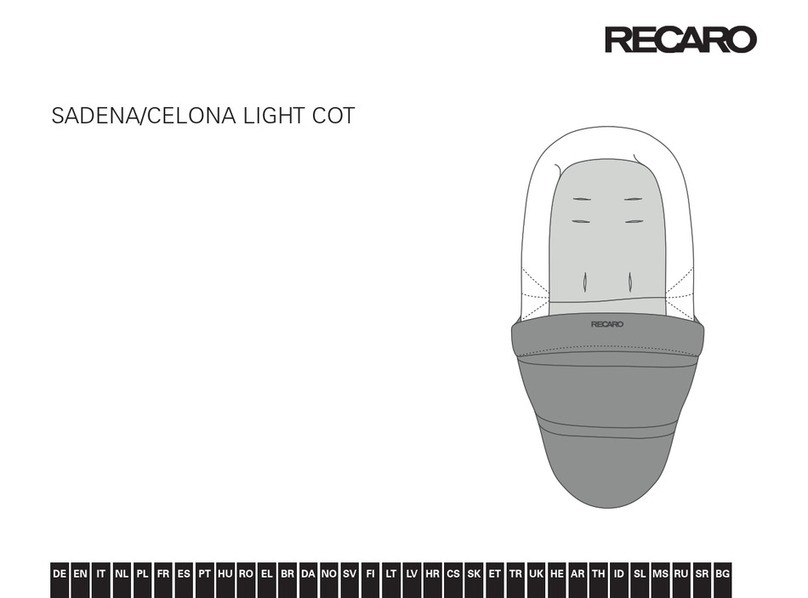Sling Pitcher SP User manual

OP E R AT I O N MA N U A L
Sling Pitcher Inc.
10105 W Claudia Rd
Boise, Idaho 83714
www.slingpitcher.com
Patent # 6,884,188

T
M
Letter from the President, Mr. Kim N. Cherry
Thank you for your purchase of the Sling PitcherTM. We welcome you to our family and encourage
you to take the time to read and study this manual.
As most effective inventions do, the Sling PitcherTM was developed to solve a problem. My
youngest son, Brandon, has always played and loved baseball, and I have always loved coaching and
working with him. I have thrown thousands of pitches during hours of batting practice. As his skills
increased, mine decreased, both from age and from the wear and tear that comes with throwing too many
pitches.
I developed the Sling PitcherTM to be able to continue challenging Brandon, and to allow myself
to be able to sleep at night without my arm and shoulder being in constant pain. Whether you have
purchased the Sling PitcherTM for your baseball or softball team, for individual at-home practice, or
simply for some wholesome backyard family activities, you will find the Sling PitcherTM to be a great
source of family and/or team fun, and a great way to improve the hitting and fielding skills of ball
players, young or old.
Though the Sling Pitcher is fun and versatile, it is also a high quality piece of sports training
equipment, and should be handled and treated with care, and always, with safety in mind.
Built of a composite material of polycarbonate and ABS plastics, the Sling PitcherTM will provide
years of great training, fun and excitement. However, it can be damaged and may even cause personal
injury to the operator or others around that are receiving balls if it is not used or maintained in a proper
manner. Please take the time to read this manual to learn how to properly use and care for your Sling
PitcherTM. Always use the appropriate safety equipment applicable to the use and ages of users and
operators of your Sling PitcherTM and the type of ball that is being used. When younger children are
using the Sling PitcherTM, adult supervision is always highly recommended.
With the addition of the optional Sling Turret, a swivel base giving the Sling Pitcher instant rotation,
and the Sling Guard, a protective screen for the operator, the Sling Pitcher is truly the most versatile,
effective, and affordable training tool for youth baseball and softball on the market. I expect you will soon
agree. We would love to receive your feedback on our website, www.slingpitcher.com, (testimonial page).
Respectfully Yours,
Mr. Kim N. Cherry, P.E.
President & Inventor, Sling Pitcher Inc

page 3
Table of Contents
Safety Warnings p. 3
Package Contents p. 4
Sling Arm Assembly p. 4
Assembly of Sling Pitcher unit p. 5
Disassembly Instructions p. 6
Operating Instructions p. 7
Fly-Ball Arm Instructions p. 8
Maintenance and Storage p. 8
Accessories p. 8
Sling Guard
Sling Turret
Replacement Parts p. 9
Repairing a Broken Elastic p. 9
Repairing a Leather Pouch p. 9
Training & Practice Drills p. 10
Warranty p. 11
Contact Information p. 11
All information, illustrations, specifications, and descriptions in this manual are based on the latest information
at the time of publication. Sling Pitcher Inc. reserves the right to make changes at any time without notice.
Illustrations may include optional equipment and accessories.
Training and help videos are available at www.slingpitcher.com, and on various U-tube videos.
Important Safety Warnings
1. Always use with adult supervision.
2. Always wear complete and appropriate protective headgear with facemask and eye protection.
3. Never kneel on, stand on, or jump over the Sling PitcherTM, or allow children to do the same.
4. Never apply loads directly to the Sling Arms, but only through the pouch and elastics assembly.
5. Never aim the Sling PitcherTM directly towards another person, animal or breakable object.
6. Read and follow the operating instructions for the Sling Pitcher that are included in this manual.
7. Use the Sling Guard or other equivalent protection, to protect against returned ball injuries
when using any balls that could cause injury to operator if returned at high speeds. Regulation
baseballs or softballs may cause damage to the Sling PitcherTM, if struck at high speeds.

page 4
Package Contents
The Sling Pitcher will come packaged with the following items:
One seat with spring clips inserted into the connector posts, one basket, one Sling Arm Assembly
consisting of two Sling Arms four elastics, a leather pouch, and the connecting tabs, tees, and
hardware, two Fly Ball Arms, two Sling Pitcher “U” shaped legs, one extra set of elastics, an
assortment of twelve practice balls (9” and 12” perforated plastic or foam), one Sling Pitcher
storage and carry bag, and one Instructions Manual.
Seat Basket Sling Arm Assembly Fly Ball Arms
Leg (Two) Practice Balls (12) Carry Bag
Sling ArmAssembly Setup
Barbed “T”Connector
Nylock Nut
Washer - flat
“T”Straps
Sling Arm
'T'
Elastic
Carriage Bolt
Pouch w/
“T”s and
Grommet
(At Top)
Quantity Part Description
1Pouch
2Sling Arm
8 T
4 T Strap
4 Elastic
4 Carriage Bolt (3/16”X 1¼”)
4 Nylock Nut
4 Flat metal washer
The Sling Arm Assembly will come completely assembled. This illustration is given should it ever be necessary
to replace these parts.
The Connector “T”s are sewn into the leather pouch. The seams of the pouch have been sealed, and should not
work loose. To insert the elastics on the “T”s, apply a drop of rubbing alcohol to the barbed portion of
the ”T”. Grip the “T” firmly in one hand and push the elastics on to the “T” until it completely covers
the “T”. Alittlesalivaonthe“T”will alsowork,butnotaswell.Thoughlubricants such soap or vegetable oil or other
oil based lubricants make insertion much easier, they will also cause the elastics to slip off during use and
should not be used.
It is important the pouch be aligned as shown, with the grommet at the top of the assembly, such that the pouch
is in a vertical position. The grommet is for use with the optional Sling Guard.

page 5
Set-up Instructions for the Sling Pitcher
1. Slide the two prongs of the seat into the two outlets of the basket until they snap into place.
note spring
button
2. Insert the two leg assemblies into the four openings of the seat and basket (two on each).
3. Place the Sling PitcherTM on its legs. Position the two sling arms so that the four “T”s attached
to the Sling Arms are all facing towards the center and the leather pouch is positioned with the
smooth side facing the operator and the rough side facing away from the operator. Insert the two
Sling Arms down into the basket sockets until they click into place. Be certain that the arms
curve away from the operator and over the front of the Sling PitcherTM, such that the ball and
pouch can be gripped as shown. Note the location of the pouch grommet.
4. If using the Fly-Ball Arms, insert the arms into the basket
sockets until you hear a click (figure 1). Place the Sling Arms
into the Fly-Ball Arm sockets until you hear a click (figure 2).
Figure 1 Figure 2 Figure 3

page 6
Disassembly Instructions
1. Reach down to the bottom of the arms. Lift up on the locking lever located at the bottom of the
arms until the arms are unlocked and can be easily slid out of position (see figure 4).
2. Remove the two leg assemblies.
3. Locate the two release buttons between the seat and the basket on the underside of the unit.
Press the buttons and pull the seat away from the basket. If only one person is disassembling the
unit, release the button on one side and pull apart enough to maintain depression of the release
button. Repeat on opposite side.
4. If using the Fly-Ball Arms, they install and release in the same manner as the Sling Arms. Release the
arms by lifting up on the locking lever at the bottom of the Fly-Ball Arms until they are unlocked. Slide
them out of the basket sockets.
5. If the Sling Arms, Fly-ball Arms, or Leg Assemblies become jammed in their respective sockets, use a
regulation baseball or softball to tap on the release heal of the Arms, or on the inside of the Legs to
break loose. (see photos below)
figure 4
Placing the Sling Pitcher in the Carry Bag
To place Sling Pitcher Assembly in the carry bag, stack the legs on top of each other at one end
of the bag. Set the basket inside the legs and on the bottom of the bag. Place the Sling Arms
inside the basket, and set the seat on top of the basket. Place the Fly Ball Arms on the Seat with
the pockets toward the front corner and over the open end, as shown below.

page 7
Operating Instructions
1. To operate the Sling Pitcher sit on the Sling Pitcher seat with both feet firmly on the ground. The
Operator should always wear safety glasses, or other eye protection, and a batting helmet, if there
is any danger from hard hit returned balls.
2. Place the ball in the pouch, and grasp the leather pouch around the ball (see fig.5). It is
important that the grommet of the pouch be at the top, and that the pouch be in a vertical
position. The fingers or thumbs should never touch the ball, but only the leather of the pouch.
Place the thumbs on top of the pouch, over the ball, and the fingers on the bottom of the pouch,
below the ball.
figure 5 figure 5.1
3. Pull the pouch directly toward the belt buckle location and release, in one fluid motion. Never
hold the ball before release. To increase the speed of the pitch, sit further back on the seat and
pull further. Snapping the wrist at release of the pouch will further increase the speed of the
pitch. To reduce the speed of the pitch, release the ball sooner in the pulling motion.
Placement of the ball in the strike zone can also be altered to the operator’s desire, by altering
the direction of pull of the pouch. Pulling the pouch a fraction to the left will throw the ball to
the inside of a right-handed hitter. Pulling to the right, will throw an outside pitch
4. Placing the ball in the direct center of the pouch directly over the hole will throw the ball with
very little spin creating a knuckle ball effect (fig 6). To create a top spin simply rotate the
pouch moving the ball to the top of the pouch so that the grommet is more toward the back of
the ball creating a curve ball effect (fig.7). Likewise, the ball can be moved to the bottom of
the pouch, creating a reverse, bottom spin, simulating more the fastball pitch (fig 8). Foam
balls with raised seams are much more susceptible to air friction and will have more
movement. Smooth finish balls such as perforated plastic balls and tennis ball, will fly
straighter and truer. Adjusting the position of seamed foam balls in the pouch will result in
nice curve or breaking balls.
figure 6 figure 7 figure 8

page 8
5. The Sling PitcherTM can throw virtually any type of baseball, softball, or tennis ball. Regulation
baseballs and softballs will not attain the same velocity as lighter balls, but can cause significant
damage to the operator, or the Sling Pitcher, if returned by a batter at a high rate of speed. These
balls should not be used without the use of the protective Sling Guard, if there is any danger to
the operator or the Sling Pitcher. It is the sole responsibility of the operator, or adult supervisor
to determine the risk involved and to take proper steps to protect against returned balls.
It is important that the operator maintain a consistent, fluid motion, especially at high speeds, to
allow the batter to adjust to the flight of the ball, and time his/her hitting motion. If the hitter still has
trouble anticipating when the ball will be released, a simple nod of the operator’s head, or some verbal
signal such as “ball”, just as the operator starts his/her motion will allow the hitter to adjust to the
release of the ball. (Recognizing change-ups is the challenge and responsibility of the hitter).
Use with the Fly-BallArms
The Fly-Ball Arms allow baseballs to be thrown in excess of 150 feet vertically, and to a horizontal
distance of approximately175 feet, on the fly. (See instructions for placement of the Fly-Ball Arms
under “Set-up of Sling Pitcher” on page 5). The operating instructions for the Fly-Ball arms are
the same as for throwing pitches, except that the pouch is pulled down into the basket of the Sling
PitcherTM, instead of into the mid-section of the operator.
When using the Fly Ball Arms, the operator should always wear safety glasses, or other protective
eyewear. On occasion, it is possible the Sling Arms or the Fly-ball Arms may inadvertently dislodge
from their sockets during operation. This is most likely to happen when shooting very lightweight
balls, such as the perforate plastic balls. It is recommended that the perforated plastic balls not be
used with the Fly-Ball Arms.
It is important that the operator sit firmly on the Sling Pitcher seat when shooting the fly balls, and
that both feet remain firmly on the ground. The Sling Pitcher Pouch should always be pulled down
into the basket, and never at an angle above the line to the operator’s belt line. Pulling the pouch
at a higher angle could cause damage to the Sling Pitcher or injury to the operator.
Maintenance and Storage (and cold weather use)
To clean the Sling PitcherTM, wash with warm soapy water and wipe dry with a cloth. Store the Sling
PitcherTM in a cool dry area. Keeping the Sling PitcherTM out of direct sunlight when not in use will
extend the life of the elastics and leather pouch. For best storage, keep the Sling PitcherTM in the
supplied carrying case when not in use. Avoid extreme temperatures. Operating the Sling Pitcher in
extreme cold (below freezing) will make the unit more susceptible to damage or parts failure.
Accessories
The present line of accessories includes all parts to the Sling PitcherTM, (plastic parts, elastic bands,
and leather pouch) as well as the plastic and foam balls and the carry bag.
The Sling Guard is a protective shield that works in conjunction with the Sling PitcherTM to provide
greater protection to an operator from returned balls. It is highly recommended the Sling Guard be used
whenever there is a risk of injury to the operator by returned balls from a batter. Even with the use of
the Sling Guard, the operator should always use protective gear, including, but not limited to, a helmet
and safety glasses.
The Sling Turret is a swivel base that fits beneath the Sling PitcherTM and allows the operator to rotate
to any field or position. This is especially effective for outfield and infield drills. The Sling Turret
and Sling Guard can also be purchased on line at www.slingpitcher.com, or from any authorized
dealer or retail outlet.

page 9
The Sling Guard and the Sling Turret are sold separately
Sling Guard
Sling Pitcher
See website for action photos of
the Sling Guard and Sling Turret
Sling Turret
The Sling PitcherTM is shown above with Sling Guardand Sling Turret.
Replacement Parts
With normal wear and tear, some parts of the Sling PitcherTM may eventually need replacing.
Any broken parts covered under warranty will be replaced free of charge, when returned to Sling
Pitcher, Inc, 10105 W Claudia Road, Boise, Idaho 83714. Replacement parts such as the pouch
assembly and the connector “T”s, will be sold only to verified Sling PitcherTM owners.
Repairing a Broken Band
When an elastic band breaks, usually, just the portion of the band that is attached to the “T”s is
worn. The elastic can be cut off (only scissors should be used to cut the elastics) and reattached.
The shorter elastic will continue to work, even though with a shorter life, until new elastics can
be obtained. Use rubbing alcohol or saliva to lubricate the barbed “T”before attaching elastics.
To replace a broken band, simply remove the broken bands by pulling them off by hand, or using
a pair of pliers. (Note: Bands will generally release from “T”s with approximately 20 lbs. of
force). Knives, utility knives, scissors or razor blade should never be used for cutting pieces
elastics from the “T”s. These pieces are easily removed by pinch gripping the elastic piece with
a pair of pliers and pulling them off. They can also, with a little more effort, be peeled off by
hand. This is done by rolling the broken elastic from the inside end closest to the leather tab or
pouch, similar to removing a sweater from the bottom up.
Repairing a Broken Leather Pouch
The pouches are made from high quality leather and should last for several years. The most
likely wear issue is that the sewing of the “T”s may work loose. If this happens, any shoe repair
or leather shop can quickly sew the leather again. If the leather does tear, the old leather can
be used to make a pattern to have a new pouch made at a leather shop. The leather pouches are
guaranteed for one year. After the warrantee, new pouches can be ordered on the Sling Pitcher
web site, or by calling 1-877-sling-77 (877-754-6477).

page 10
Training & Practice Drills with Sling PitcherTM
The Sling Pitcher is the most complete and versatile pitching/training machine on the market, at any price.
The following drills and practice options will help develop baseball/softball skills in players of all ages
and skill levels.
1. Standard pitching and hitting drills: The ball can and should be moved around in the strike zone at
various speeds. This practice enables the players to learn to anticipate the pitch, and watch the ball
all the way through the strike zone. If regulation balls are used, the optional Sling Guard should
be used to protect the operator from line drives back to the pitcher.
2. Taking the inside pitch: Using plastic perforated or foam balls, work the inside of the plate. Teach
the players the correct moves to take an inside pitch. As the skills and the confidence of the
players increase, move to the regulation balls. Again, the optional Sling Guard should be used
whenever there is danger to the operator from returned balls from a hitter.
3. Ground Ball Drills: Since the operator has complete control of the shot, balls can be thrown as line
drives, short hoppers, or traditional grounders. Use of the optional Sling Turret accessory, which
allows the operator to rotate to any infield or outfield location, will make this drill much more
effective.
4. Catcher Training: Pitches can be thrown at any point into the dirt, allowing coaches to work with
catchers on the proper techniques for shifting and blocking. Plastic or foam balls can be used
until young catchers learn to trust their equipment, before moving to regulation balls.
5. Pop-ups & High Foul Ball Drills: By inserting the Fly Ball Arms that are included with every
Sling Pitcher, pop-ups can be thrown to any part of the infield for work on “in field fly rules” for
both runners and fielders. High foul pop-up drills behind the plate, are best performed by moving
the Sling Pitcher to the front of the catchers box and shooting the ball straight up. The reverse
spin will carry the ball to the back stop, simulating an actual pop-up foul ball.
6. First Base Training: Balls can be thrown into the dirt for a scoop, or a short-hop or bounced further
in front of the bag for the tougher play. Stretch throws are also easily simulated.
7. Outfielder Fly Ball Training: Since the Sling Pitcher allows the operator to accurately place a ball
to almost any spot on the field, players can work on fly balls over either shoulder, straight back, in
front, or to either side. The high flies can be thrown, or the lower flight line drives. Again, using
the optional Sling Turret allows the operator to easily rotate to either side of the fielder, making the
drill much more fun, as well as effective.
These are drills that other coaches and parents have used. As you come up with additional drills that
work for you, we would love to know about them.

Warranty
All Sling PitcherTM products are backed by a 1 year limited warranty when purchased from an authorized dealer,
distributor, wholesaler, retailer or reseller. Sling Pitcher’s limited warranty is extended to the original consumer
purchaser and to no other purchaser or transferee of the product. Sling PitcherTM warrants to the first consumer
purchaser that this Sling PitcherTM product when shipped in its original container will be free from defective
workmanship and materials and agrees that it will, at its option, either repair the defect or replace the defective product
at no charge to the purchaser for parts or labor for 1 year from the date of purchase. This warranty does not apply to any
product which has been subjected to misuse, abuse or which has been altered or modified in design or construction. This
warranty does not cover worn or damaged elastic tubing. Balls of any kind and the carry bag are also excluded from this
warranty.
There are no other warranties express or implied. The limited warranty described herein is the sole and exclusive warranty
granted by Sling PitcherTM and shall be the sole and exclusive remedy available to the purchaser. Sling PitcherTM
SPECIFICALLY DISCLAIMS AND EXCLUDES ANY IMPLIED WARRANTY OF MERCHANTABILITY OR
FITNESS FOR ANY PARTICULAR PURPOSE. Sling PitcherTM FURTHER DISCLAIMS AND EXCLUDES ANY
WARRANTY FOR INCIDENTAL OR CONSEQUENTIAL DAMAGES INCLUDING, BUT NOT LIMITED TO,
PROPERTY DAMAGE, PERSONAL INJURY OR ECONOMIC DAMAGE.
Sling PitcherTM requires a receipt as proof of purchase. Therefore, we strongly recommend that you retain your original
sales receipt.
If the Sling PitcherTM you have purchased meets the failure requirements specified above within 1 year of purchase, please
contact us at Info@slingpitcher.com or call our Customer Service Department 1-877- SLING77 (1-877-754-6477) to
process your return.
To obtain replacement parts or products, please go online at slingpitcher.com to order. Sling PitcherTM Inc. is not
responsible for items returned without prior authorization.
Contact Information:
Sling Pitcher Inc.
10105 W Claudia Rd
Boise, Idaho 83714
1-877-SLING-77
(1-877-754-6477)
info@slingpitcher.com
page 11
Table of contents
Popular Accessories manuals by other brands

Saramonic
Saramonic SR-MLP4 quick start guide

Keysight Technologies
Keysight Technologies EL30000 Series user guide

ML
ML BT CTEMS Series Installation & maintenance manual

Seifert
Seifert SlimLine Pro KG 8508 instruction manual
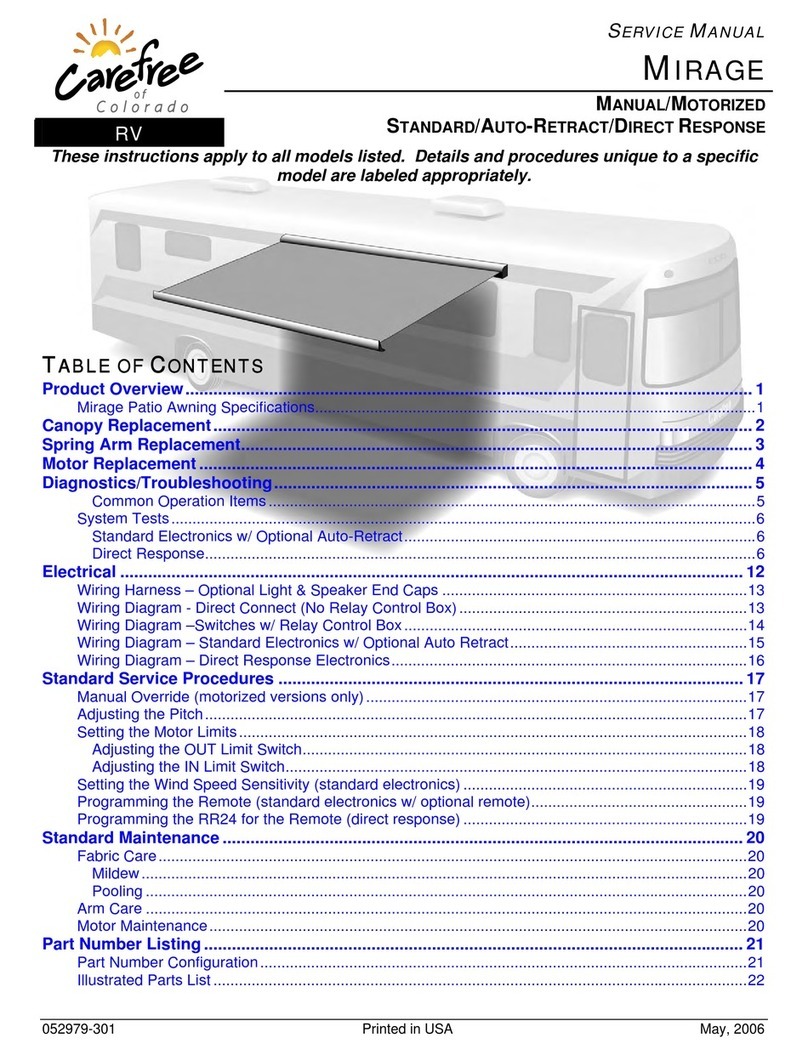
Carefree of Colorado
Carefree of Colorado Mirage Service manual

Schumacher Electric
Schumacher Electric 1222 owner's manual




